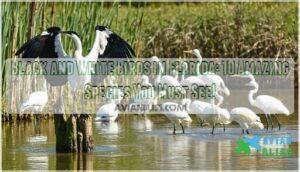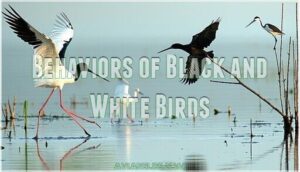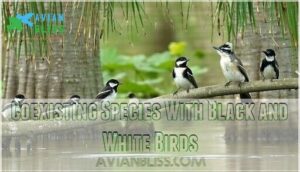This site is supported by our readers. We may earn a commission, at no cost to you, if you purchase through links.

The Anhinga’s your go-to "snake bird" with its distinctive drying-wings pose after fishing.
White Ibis flock together like nature’s cleanup crew, while Black-necked Stilts strut on impossibly long legs through shallow waters.
Don’t miss the Laughing Gull’s comedic calls at beaches or the elegant Black Skimmer’s unique feeding style.
These monochromatic marvels have found their sweet spot in Florida’s diverse ecosystems, from Everglades wetlands to coastal marshes.
Each species brings its own personality to the table – some are year-round residents, others just passing through.
The best viewing spots and identification tricks reveal surprising secrets about their fascinating behaviors.
These birds are a treasure to observe, with their unique characteristics and habits making them a joy to watch in their natural habitats, and learning about their diverse ecosystems is key to understanding their importance.
Table Of Contents
- Key Takeaways
- The Black and White Birds of Florida
- Unique Characteristics of Black and White Birds
- Habitat Preferences of Black and White Birds
- Behaviors of Black and White Birds
- Threats Faced by Black and White Birds
- Conservation Efforts for Black and White Birds
- Symbolism of Black and White Birds
- Migration Patterns of Black and White Birds
- Coexisting Species With Black and White Birds
- Birdwatching Tips for Black and White Birds
- Frequently Asked Questions (FAQs)
- What Florida bird is black and white?
- What type of bird is white and black?
- What is a black and white bird with a split tail in Florida?
- What is a black and white striped bird called?
- What is the black and white bird in Florida?
- What does it mean when you see a black and white bird?
- What is a common white and black bird?
- What does a black and white warbler look like?
- How can I attract black and white birds to my backyard?
- What are some unique behaviors or adaptations of black and white birds?
- Conclusion
Key Takeaways
- You’ll find diverse black and white birds across Florida’s ecosystems, from the Anhinga’s distinctive "snake bird" pose in wetlands to Black Skimmers gracefully hunting along coastal waters with their specialized bills.
- You can easily identify these species by their unique behaviors – White-breasted Nuthatches walk headfirst down trees, Carolina Chickadees announce themselves with their famous calls, and Northern Mockingbirds flash white wing patches during territorial displays.
- You’ll have the best success attracting these birds by setting up tube feeders with sunflower seeds and suet, planting native trees for nesting spots, and providing fresh water sources in your backyard.
- You’re witnessing conservation success stories when you spot these birds, as habitat restoration efforts, protected areas, and citizen science programs are actively working to preserve their populations despite threats from development and climate change.
The Black and White Birds of Florida
Picture yourself walking through a Florida cypress swamp when a black and white bird darts past—that’s the magic waiting for you.
Florida’s black and white birds showcase incredible plumage variations, from the Carolina Chickadee’s crisp cap to the Downy Woodpecker’s striking patterns.
These Florida birds aren’t just pretty faces; their feeding habits reveal fascinating adaptations. The White-breasted Nuthatch walks headfirst down tree trunks, while Black Skimmers use their unique bills to skim water surfaces.
Bird identification becomes easier when you notice their distinct vocalizations—from mockingbird melodies to chickadee calls. Whether you’re spotting black and white bird species in your backyard or exploring coastal marshes, Florida bird identification opens doors to understanding these remarkable creatures that call the Sunshine State home.
Some species, like the Black Vulture, have omnivorous diets, including carrion.
Unique Characteristics of Black and White Birds
Florida’s black and white birds showcase remarkable Physical Attributes that make each species instantly recognizable.
You’ll notice how Plumage Patterns create striking contrasts—the White-breasted Nuthatch’s crisp white cheeks pop against its gray-blue back, while Carolina Chickadees sport their signature black and white plumage with that adorable dark cap and bib combo.
Feeding Adaptations tell fascinating stories. Downy Woodpeckers developed shorter, chisel-like bills perfect for pecking suet, while Black Skimmers evolved that weird longer-lower-mandible setup for water skimming—talk about specialized equipment!
Vocalizations vary dramatically too. Northern Mockingbirds can mimic dozens of other birds (show-offs!), whereas nuthatches make those distinctive nasal calls.
Mating Rituals often highlight these contrasts beautifully. Male woodpeckers flash their red head patches during courtship displays.
These Florida birds prove that black and white plumage isn’t boring—it’s nature’s way of creating living works of art in Florida avifauna. Many species use their coloration for communication and warnings.
Habitat Preferences of Black and White Birds
Black and white birds in florida have mastered the art of home selection, each species claiming its perfect spot in the Sunshine State’s diverse landscape.
These feathered residents don’t just randomly pick places to live – they’re surprisingly picky about their Florida bird habitats.
Bird homes aren’t accidents—these feathered Florida residents are choosier than luxury hotel guests when selecting their perfect addresses.
Coastal Habitats attract Black Skimmers and American Oystercatchers, who love sandy shores and shallow waters for fishing. These coastal regions provide the perfect hunting grounds where they can snatch fish and shellfish with specialized beaks.
Wetland Birds like Black-necked Stilts prefer marshes and swamps, where their long legs help them wade through murky waters hunting for small fish and insects. These wetlands offer rich feeding opportunities year-round.
Forest Dwellers such as Black and White Warblers choose wooded areas during migration, searching tree bark for insects. Their striking plumage offers camouflage and adaptation within these environments.
Meanwhile, Urban Adaptations are becoming common – Northern Mockingbirds thrive in suburban backyards, proving that bird habitat preferences can evolve. Nesting Locations vary dramatically, from treetops to ground level, depending on each species’ unique needs and safety requirements.
Behaviors of Black and White Birds
Masters of adaptation, Florida’s black and white birds showcase behaviors that’ll leave you amazed.
You’ll witness feeding habits ranging from aerial acrobatics to methodical bark-probing techniques.
These Florida birds demonstrate remarkable diversity in their daily routines.
| Behavior Type | Examples |
|---|---|
| Feeding Habits | Nuthatches walk headfirst down trees, woodpeckers drum for insects, skimmers slice water surfaces |
| Social Interactions | Chickadees form mixed flocks, mockingbirds defend territories aggressively, stilts gather in feeding groups |
| Flight Patterns | Swallow-tailed kites soar effortlessly, woodpeckers fly in undulating patterns, skimmers skim low over water |
Mating rituals include elaborate courtship displays—mockingbirds flash their white wing patches while singing complex songs.
Vocalizations serve multiple purposes: chickadees use contact calls, while woodpeckers drum territorial messages.
You’ll notice these black and white plumage birds adapt their behavior seasonally.
Winter brings mixed-species flocks for protection, while spring triggers territorial disputes.
Their Florida bird behavior reflects millions of years of evolution, perfectly suited to the Sunshine State’s diverse ecosystems.
Some species even exhibit fascinating mobbing behavior to defend against predators.
Threats Faced by Black and White Birds
You’ll find that black and white birds in Florida face mounting challenges that threaten their survival. Habitat loss tops the list, with roughly 70% of bird habitat transformation coming from human development. Urban sprawl squeezes these feathered residents into smaller spaces, making resources scarce and forcing risky nesting choices.
Climate change compounds problems by shifting migration patterns and breeding cycles. Rising temperatures threaten 30% of suitable habitat by 2050, while extreme weather disrupts population stability.
Pollution impacts hit hard too—microplastics contaminate 92% of marine feeding areas, and heavy metals cause reproductive issues. Invasive species muscle out native birds through aggressive competition, costing Florida $500 million annually in management efforts.
Human disturbance fragments migration corridors, creating additional stress. These bird threats demand immediate attention for effective bird habitat preservation and maintaining healthy bird population trends. Collisions with structures cause significant bird mortality, adding to these challenges.
Conservation Efforts for Black and White Birds
Conservationists are working around the clock to protect Florida’s stunning black and white birds. Bird conservation efforts across the state tackle multiple challenges through thorough strategies that you can support too.
The U.S. Fish & Wildlife Service works to guarantee the ecological sustainability of these populations.
Florida’s bird species conservation programs focus on four key areas:
- Habitat Restoration – Replanting native trees and restoring wetlands to create safe nesting grounds
- Protected Areas – Establishing sanctuaries where birds can breed without human interference
- Reducing Pollution – Cleaning waterways and limiting pesticide use in critical feeding zones
- Public Awareness – Teaching communities about black and white birds in Florida through educational workshops
Citizen Science programs let you contribute by reporting bird sightings and participating in annual counts. Organizations like Audubon Florida partner with local groups to monitor population changes and track migration patterns.
These bird conservation initiatives work because they combine scientific research with community involvement. When you spot a Black and White Warbler or Carolina Chickadee, you’re witnessing conservation success in action.
Symbolism of Black and White Birds
Throughout history, bird symbolism has captivated cultures worldwide, and Florida’s black and white birds carry profound meaning that’ll resonate with your soul.
These striking creatures embody the classic concept of Yin and Yang – representing balance, duality, and life’s eternal dance between opposing forces.
When you spot black and white birds in Florida, you’re witnessing nature’s own spiritual meaning in action.
Here’s what these magnificent creatures symbolize:
- Good versus Evil – The contrast represents life’s moral struggles and the balance we all seek
- Transformation and Change – Like the Black and White Warbler’s seasonal journey, they remind us that change brings growth
- Cultural Significance – Many Native American traditions view these birds as messengers between earthly and spiritual domains
Florida birds identification becomes more meaningful when you understand these deeper connections that’ve inspired humanity for centuries.
Their striking plumage may also serve as communication and warning within their species.
Migration Patterns of Black and White Birds
Beyond their powerful symbolism, black and white birds in florida showcase fascinating migration patterns that’ll transform your birdwatching adventures.
Migration triggers like changing daylight and temperature push species like the Black-and-white Warbler toward their breeding grounds in Canada each spring, while they return to Florida’s warm embrace by September.
These aerial travelers rely on incredible navigational skills, using stars, magnetic fields, and landmarks to find their way.
Stopover sites become essential pit stops where birds refuel—think of them as nature’s rest areas along major highways.
The Swallow-tailed Kite demonstrates this perfectly, soaring gracefully between wintering habitats in Central America and Florida’s summer territories.
Birds utilize visual landmarks like rivers and mountains.
However, not all black birds florida and white birds florida follow this pattern.
Northern Mockingbirds and Downy Woodpeckers stay put year-round, making them reliable backyard companions.
Understanding florida bird migration timing helps you predict when to expect these stunning visitors at your feeders.
Coexisting Species With Black and White Birds
When you spot black and white birds in Florida, you’re witnessing nature’s ultimate roommate situation.
These striking species don’t live in isolation – they share their homes with fascinating neighbors through complex Habitat Sharing arrangements.
Carolina Chickadees and Downy Woodpeckers form unlikely partnerships, with Interspecies Communication helping them locate food sources together.
The bold Northern Mockingbird creates interesting Predator-Prey dynamics by chasing smaller birds while simultaneously protecting shared territories from real threats.
Resource Competition stays surprisingly low because these species have developed different feeding strategies.
White-breasted Nuthatches work tree bark while chickadees prefer branch tips – it’s like having upstairs and downstairs neighbors who never fight over the bathroom.
Some relationships border on Symbiotic Relationships, where mixed flocks provide extra eyes for danger.
These birds contribute substantially to seed dispersal efforts, aiding in plant propagation.
This cooperative living makes Florida bird watching incredibly rewarding, as you’ll often spot multiple black birds Florida and white birds Florida species in single locations during bird identification Florida adventures.
Birdwatching Tips for Black and White Birds
How can you maximize your chances of spotting Florida’s stunning black and white birds? Success lies in proper preparation and knowing what to look for in the field.
Binocular Selection makes all the difference—choose 8×42 models for crisp views of distant Carolina Chickadees and White-breasted Nuthatches. Field Guides specific to Florida bird watching help you quickly identify species by their Identifying Marks.
Notice the Northern Mockingbird’s flashy white wing patches or the Downy Woodpecker’s tiny red cap.
Here are four essential bird watching tips for black and white birds:
- Listen First: Carolina Chickadees announce themselves with their famous "chick-a-dee-dee" call
- Check Feeders Early: Visit backyard feeders at dawn when nuthatches are most active
- Practice Ethical Birding: Keep respectful distances and avoid disturbing nesting sites
- Master Photography Tips: Use natural lighting to capture sharp black bird sightings without flash
Patience pays off—these contrasting beauties reveal themselves to those who wait quietly and observe carefully. Consider the importance of camouflage for these birds when searching.
Frequently Asked Questions (FAQs)
What Florida bird is black and white?
Florida’s absolutely bursting with black and white birds.
You’ll spot Carolina Chickadees with their distinctive black caps, White-breasted Nuthatches climbing trees headfirst.
And elegant Black Skimmers gracefully hunting along coastal waters.
What type of bird is white and black?
You’ll find several black and white bird types in Florida. Woodpeckers like Downy and Hairy species sport this classic combo. Chickadees, nuthatches, and warblers also rock the monochrome look beautifully.
What is a black and white bird with a split tail in Florida?
You’re looking at a Swallow-tailed Kite! This magnificent raptor sports white underparts, black wingtips, and that signature deeply forked tail. They’re summer visitors to southeastern Florida with impressive five-foot wingspans.
What is a black and white striped bird called?
Picture a tiny acrobat clinging upside-down to your oak tree’s bark.
You’re likely spotting a Black and White Warbler – nature’s striped zebra with wings that creeps along branches like a feathered woodpecker.
What is the black and white bird in Florida?
You’ll spot several black and white birds across Florida! The Northern Mockingbird’s your most common backyard visitor, while Carolina Chickadees and White-breasted Nuthatches frequent feeders in northern regions year-round.
What does it mean when you see a black and white bird?
Over 40% of bird species display black and white coloring worldwide.
When you spot a black and white bird, it typically means you’re witnessing nature’s perfect contrast – these birds use their bold patterns for communication, camouflage, and attracting mates.
What is a common white and black bird?
You’ll spot the Northern Mockingbird everywhere in Florida – it’s probably the most common black and white bird you’ll encounter.
These bold singers love showing off their distinctive white wing patches.
What does a black and white warbler look like?
Coincidentally, you’ll recognize this striped beauty by its bold black upperparts streaked with white and distinctive black wings sporting two white wing bars that look like spots when folded.
How can I attract black and white birds to my backyard?
You’ll want to set up tube feeders with sunflower seeds, peanuts, and suet.
Plant native trees and shrubs for nesting spots.
Provide fresh water sources. These simple steps create an irresistible backyard buffet for visiting species, making it a haven with native trees.
What are some unique behaviors or adaptations of black and white birds?
You’ll notice fascinating adaptations like the Black Skimmer’s specialized bill that skims water surfaces.
While Anhingas dive underwater with snake-like necks.
Nuthatches walk headfirst down trees using strong claws for unique feeding angles.
Conclusion
Over 400 bird species call Florida home, yet these striking black and white birds in Florida represent some of nature’s most enchanting contrasts.
You’ve discovered ten remarkable species that showcase incredible adaptations, from the Anhinga’s snake-like neck to the Black Skimmer’s precision feeding technique.
Whether you’re exploring coastal marshes or inland wetlands, these monochromatic marvels offer endless opportunities for observation.
Grab your binoculars and venture out – Florida’s black and white avian treasures are waiting to amaze you with their unique behaviors and stunning appearances.










